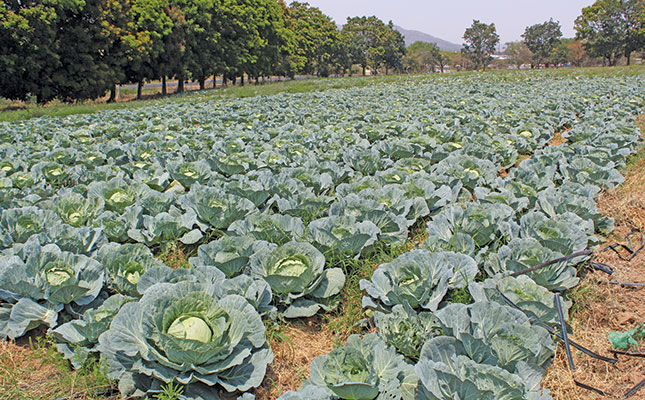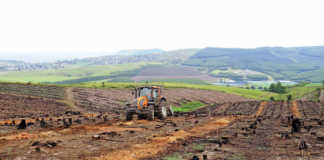
Photo: Lindi Botha
Seizing a unique opportunity two years ago, Bright Matimbe capitalised on a shortage of locally produced cabbage in Mbombela, Mpumalanga, and did so within a stone’s throw of the market.
“I was working full-time as a business unit manager for a farmer incubator programme, but had always dreamt of farming myself, so I kept my eyes open for a piece of land I could rent,” he recalls.
“I’d noticed for some time there was land lying idle at the Agricultural Research Council facility in the centre of town, so I approached them and [negotiated a lease] on the land.

“Cabbage was my first choice, because I saw there was an increasing demand for it in the area. And at certain times of the year here, one has to travel 300km to find cabbage. There was an opportunity on my doorstep and I took it!”
Matimbe established his business, Brightest and Fresh, on 1,2ha.
Production
Cabbage can be produced year-round, with certain varieties suited to winter and summer months. Matimbe starts his land preparation during the wet season, which is around March in the Lowveld. He ploughs the land, and grass and weeds are disced into the soil to add organic matter to it.
He also takes soil samples to determine nutrient levels and check if any soil-borne diseases are present. If the nematode population builds up, he has the soils fumigated.
Before planting, Matimbe ridges the soil to create a soft soil bed. This aids root development and enables the water to settle properly in the bed. The irrigation system is then laid out.
During his first cabbage season, Matimbe carried out a trial comparing seeds he had germinated himself and those sent to a nursery.
“I found that those grown by the nursery were not as strong as those I produced myself,” he says.
“I also had better uniformity among my seedlings. This was one of the most important lessons I learnt, because it not only saves on costs, but ensures a better crop.”
To produce the seedlings, Matimbe lays a plastic sheet on the ground and tops it with soil and compost. He then sows the seeds 1cm apart. The varieties chosen are dependent on the season, with larger cabbages grown in winter.
Once the seeds have germinated, he plants the seedlings on the land with an intra-row spacing of 60cm for the larger cabbages and 40cm for the medium-sized ones. Inter-row spacing is 1,2m. Approximately 40 000 seedlings are planted on the 1,2ha, with each plant yielding one cabbage. Harvesting starts about three months after planting.
It’s important to stagger the plantings to ensure a continuous harvest, rather than having to harvest everything at once, says Matimbe.
The cabbages are drip-irrigated at a rate of 1ℓ/ hour. The irrigation cycle is dependent on the weather and soil moisture, but can be as long as six hours a day when the temperature rises.
The fertiliser regime starts with the addition of nitrogen (N), phosphorus (P) and potassium (K) at a ratio of 2:3:4 (NPK) to the ridges before the seedlings are planted.
As the cabbages grow, Matimbe adds LAN fertiliser at a rate of 30g/ cabbage, broadcasting it by hand. He also applies a nitrogen foliar throughout the season when needed.
He notes that weeding is important at the start to ensure there’s no competition for the crop.
“Later on, once the cabbages are bigger, the weeds can be left.”
This approach saves on labour and is also better for the soil as there are no bare patches that dry out.
“Once the crop is harvested, the weeds form part of the mulch disced back into the soil,” he adds.
Pests
Matimbe says that cabbage is particularly susceptible to black rot and bollworm. For the former, he applies a copper spray; the latter requires cypermethrin at the beginning of the season. He uses Confidor to control whitefly.
Later in the season, he alternates the cypermethrin with Steward from DuPont. While Steward is pricy, it is highly effective, he says.
Labour and marketing
Cabbage is a labour-intensive crop and Matimbe employs five full-time employees throughout the year to tend, harvest and package the cabbages.
Matimbe supplies a number of supermarkets in Mbombela, as well as fresh produce distributors. Being in the centre of town is a major benefit; his delivery points are between 1km and 7km from the farm.
“It’s easy to supply the supermarkets and I can react quickly when they run out,” he says. “My distribution costs are also very low, as everything is close and I can get by with one bakkie to do my deliveries, even if it means making two trips.”
He supplies cabbage all year round, but demand is particularly high between September and January, which means prices are higher during this period.
“Cabbage consumption is stable throughout the year, but in the hotter months production declines. By ensuring I keep up with production during this time, I can get better prices.”
A key factor in Matimbe’s success is his determination to ensure consistency and quality.
“The biggest problem between the market and small-scale farmers is a lack of consistency in supply. Most farmers can supply for a certain period only and then their crop is finished, leaving the supermarket to find an alternative source. The farmers are effectively giving away their market!
“This also makes it difficult for a supermarket, as it’s not sure of supply and has to run around looking for produce. Many small-scale farmers will say the supermarkets don’t support them, but to maintain market share you have to be consistent. You need to build a good relationship with your buyers and ensure that you deliver on time, in the right quantities and with the right quality throughout the year.”
To diversify his offering and improve market share, Matimbe has also started growing pattypans, baby marrows and aubergines, and will soon start producing gooseberries.
“I’d like to scale up my production and get all the right certifications, like GlobalGAP, in place, “ he says.
“But I require more investment, which is not something my current margins allow. This is where many small-scale farmers stumble. To get to this point in the business is one thing, but to really make a success of it and scale up is another.”
Experience is the best teacher
Working as a business unit manager allowed Matimbe to add business knowledge to his farming experience, giving him a good idea of what it takes to succeed in the industry.
“Some of the most important lessons I learnt was the importance of marketing produce and how to strategise around production.
“At the incubator, we had to submit a detailed plan on the crops, putting systems in place to ensure continuous production.”
Since Matimbe is still in the early stages of his farming enterprise, he is in the process of fine-tuning his systems, using his experience to find out what works and what does not.
“It takes time to develop a foolproof system because it needs to be tailor-made for the farm,” he adds.
He notes that even with a foolproof system in place, initial budgeting should make allowances for a 10% loss of crop.
“Water, weather, pests or poor nutrition can affect the crop. If your sums are too optimistic, you could find yourself in financial trouble at the end of the season.”
Most importantly, Matimbe believes that passion makes all the difference between successful and unsuccessful farmers.
“If you have passion for something, you’re more driven to see it through,” he says.
“When things go wrong, you won’t be tempted to give up; that fire that burns inside you for farming will keep you going!”
Email Bright Matimbe at [email protected].











